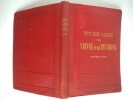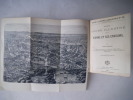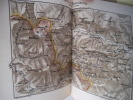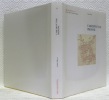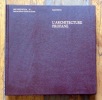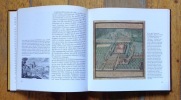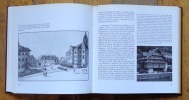-
Type
Any type (2)
Art print (7)
Book (31085)
Disk (1)
Drawings (7)
Engraving (9)
Magazine (129)
Old papers (1)
Photographs (14)
Posters (4)
-
Latest
Last 24h (3)
Last 3 days (8)
Last month (264)
Last week (53)
-
Language
Dutch (1)
English (54)
French (31158)
German (6)
Italian (18)
Japanese (2)
Portuguese (9)
Spanish (11)
-
Century
16th (16)
17th (56)
18th (209)
19th (1570)
20th (9426)
21st (1697)
-
Countries
Belgium (9480)
Brazil (7)
Canada (108)
China (3)
Côte d'Ivoire (67)
Denmark (218)
France (18275)
Germany (1)
Greece (1)
Italy (37)
Switzerland (3062)
-
Syndicate
ALAC (99)
CLAM (42)
CLAQ (94)
CNE (3)
ILAB (10904)
NVVA (1171)
SLACES (1171)
SLAM (8365)
SNCAO (9)
Unser holz.
Bern, Nationalrat ernst reinhard, 1942; in-4, 436 pp., cartonnage de l'éditeur. Band II - UNSER HOZ.
Band II - UNSER HOZ.
THEEKOEPELS EN TUINHUIZEN IN DE VECHTSTREEK,
Antwerpen , De Vries , Gebonden, 167pp. illustraties, 16x278x211 mm ISBN 9789062623624.
Overvloed en welbehagen. Nieuw. Deze uitgave is een geheel nieuwe bewerking van 'Theekoepels en tuinhuizen in de Vechtstreek en 's Graveland' (a.i. 80-47-264-8). Alleen in de Vechtstreek is die veelheid aan koepels en buitenplaatsen behouden gebleven en de Vechtkoepel dient daarom als pars pro toto voor de Nederlandse koepel (zeventiende-twintigste eeuw). Deze publikatie geeft nieuwe informatie over de sociaal-culturele betekenis van de koepel en de relatie met de omgeving; tevens is het catalogusgedeelte aangepast. Het boek vormt een zeer waardevolle aanvulling op de eerdere uitgave. Tweekolommendruk. Geillustreerd met foto's in kleur en zwart-wit, reproducties van oude gravures en tekeningen. Met een verklarende woordenlijst. (Biblion recensie, Drs. C. Laarman-Vaatstra.)
l'architecture et la géometrie symetries et rythmes harmoniques
1968 Paris Vincent Fréal 1968 in4, broché, couverture imprimée, 99 pp illustrées
bon état
L'Architecture et la géométrie, symétries et rythmes harmoniques
Vincent, Fréal & Cie 1968 In-4 28 x 23 cm. Broché, couverture grise, auteur & titre en bleu sur le dos et le premier plat, 93 pp., figures dans le texte, table des matières.
Préface de Albert Laprade.
Libye grecque, romaine et byzantine
, Edisud, 2007 Softcover, 207 pages, Francais, 280 x 240 mm, Bon Etat, . ISBN 9782744901188.
Libye grecque, romaine et byzantine pr sente par le d tail les grandes cit s de la Libye antique, comme Leptis Magna, Cyr ne ou Sabratha, mais galement dix autres sites dont l'int r t contribue la richesse arch ologique de ce pays. Agr ment de textes et d'anecdotes historiques, cet ouvrage a pour objectif principal d'offrir tous ceux que passionnent les vestiges de l'Antiquit le loisir d'aborder avec pr cision et clart l'histoire des colonies grecques et romaines dans cette partie peu connue de l'Afrique du Nord ; et de parcourir chacun des sites d'une fa on raisonn e mais agr able, en recueillant le maximum d'informations sur les monuments, les mus es ou les ?uvres d'art qui ont fait leur renomm e. [...] Le livre de Jean-Marie Blas de Robl s arrive donc point nomm . En comblant une lacune, il constitue un l ment de r f rence, mais il symbolise surtout un geste d'amiti envers une terre et un peuple injustement m connus.
L'architecture et la géométrie - Symétries et rythmes harmoniques , Préface de Albert Laprade
Editions Vincent, Fréal et Cie à Paris Malicorne sur Sarthe, 72, Pays de la Loire, France 1968 Book condition, Etat : Bon broché, sous couverture imprimée éditeur grise, titres en bleu In-4 1 vol. - 96 pages
très nombreuses illustrations dans le texte en noir et blanc, épures, plans d'architecture classique 1ere édition, 1968 Contents, Chapitres : Préface - La tradition - Coupes et façades - Roses - Les plans - Cathédrales - Chapelles - L'Antiquité - Arcs de triomphe - La Grèce - Thermes - Mausolées et monuments divers - Clochers - Conclusion couverture en bon état général mais avec des traces de pliure aux coins des plats, quelques petites taches discretes, l'intérieur est sinon très propre et frais, quelques rousseurs éparses
Christus im Leiden-Kruzifixe Passionsdarstellungen aus 800 Jahren
, S ddeutsche Verlag 1985, 1985 Hardcover, 202 seiten, Deutsche sprache, 245 x 220 mm, im guten zustand,. ISBN 9783882940855.
Petit guide illustré dans Vienne et ses environs
in 12 pleine toile rouge de l’éditeur, titre doré au dos et sur le premier plat.Vienne à vol d’oiseau… en frontispice- titre, IV, 100 pages,42 gravures 2 petits plans, une petite carte du chemin de fer du Semmering, 2ème édition.A Hartleben éditeur 1898,sans le plan de Vienne.Très bon état. Guide illustré Hartleben n°39
L'IMMORTELLE CARTHAGE ET LES MYSTERES DU BLED .Préface de L. Bertrand.
Quimper , 1931 , in8br , 236pp , illustrations. Langue: Français
L’architecture profane. Ars Helvetica IV. Arts et cultures visuels en Suisse.
Disentis, Pro Helvetia / Editions Desertina 1989, 215x215mm, VIII - 289pages, reliure d'éditeur sous jaquette. Très bel exemplaire.
photos couleurs et n/b in et hors texte, Pour un paiement via PayPal, veuillez nous en faire la demande et nous vous enverrons une facture PayPal
L'architecture profane. Ars Helvetica IV, Arts et cultures visuels en Suisse.
Disentis, Pro Helvetia / Editions Desertina, 1989. In-8, plein skyvertex avec titre doré. En belle condition. Abondante iconographie en noir et en couleurs.
Au sommaire: Sites et structures de l'habitat - Les places fortes - La maison et la ferme - Le village - La ville - La ville éclatée.
François Meyer Architecture 2004-2014
JF Editions, Genève, 2014. Grand In-4, relié, 131 pages, toilure lin d'éditeur, sans jaquette, bilingue français-anglais. A l'état de neuf. Nombreuses photos en couleurs ainsi que des plans et coupes des objets concernés.
16 projets de rénovation d'immeubles anciens, parmi lesquels l'Hôtel de la Poste à Sierre (et sa magnifique véranda), le Palais de Justice à Sion, l'Ecole primaire de Vollèges ou encore la construction de la passerelle sur le Rhône du Bois de Finges.
Joseph Surchat Architecte Administrateur.
Fribourg, Saint-Paul 2014, 325x245mm, 138pages, cartonnage de l’éditeur.
photos couleurs et n/b, Pour un paiement via PayPal, veuillez nous en faire la demande et nous vous enverrons une facture PayPal
Au de-là de l’urbanisme
1968 Paris, CRU, 1968, 206x145mm, 192p., broché sous couverture imprimée.Préface de Gabriel Marcel, illustrations photographiques et plans. Bel exemplaire.(103602)
Phone number : +33 1 48 01 02 37
La Maison Bourgeoise dans le Canton de Vaud.
Genève, Slatkine 1983, 305x220mm, 161pages, reliure d'éditeur. Très bel exemplaire.
219 planches en n/b, Pour un paiement via PayPal, veuillez nous en faire la demande et nous vous enverrons une facture PayPal
Luc Tuymans: Catalogue Raisonne of Paintings Volume I: 1978-1994
, David Zwirner , 2018 Hardcover with dusjacket, 490 pages 253 x 334 x 67 . ISBN 9781941701614.
The Luc Tuymans Catalogue Raisonne of Paintings is presently being prepared. The publication will illustrate and document approximately 500 paintings by the artist from 1975 to the present day. Each work will be accompanied by detailed information about its origin, provenance, exhibition history, and a bibliography, in addition to extensive supporting material. ?This first volume in a catalogue raisonne of Tuymans's paintings surveys nearly 200 works that were vital to his artistic development. The years 1978 to 1994 witnessed the maturation of his signature method of painting from preexisting imagery-such as magazine images, Polaroids, and television footage-as well as his first solo exhibition. This publication is a testament to Tuymans's persistent assertion of the relevance and importance of painting-a conviction that he maintains even in today's digital world, when his work continues to be a touchstone for artists and scholarS
Luc Tuymans: Catalogue Raisonne of Paintings Volume 3. 2007?2018
, David Zwirner , 2019 Hardcover with dusjacket, 456 pages 253 x 334 x 67 . fine ISBN 9781941701959.
The third volume of a catalogue raisonn of Luc Tuymans?s paintings, surveying nearly two hundred works, charts the artist?s investigation into painting?s relationship to history and technology. Tuymans is widely credited with having contributed to the revival of painting in the 1990s. His sparsely colored, figurative works speak in a quiet, restrained, and at times unsettling voice and are typically painted from preexisting imagery that includes photographs and video stills. The works in this volume, made between 2007 to 2018, show Tuymans at his most virtuosic, subtly but provocatively addressing a range of topics including religion, corporatization, and cultural memory, in addition to modernism and the history of painting. The Internet, in particular, is central to these works as well as the screen?leading to a new style of contemporary image. The works are mediatized to the nth degree, despite the artist?s continuous use of the traditional medium of painting. There is a certain kind of light that comes out of a screen, which can be found in Tuymans?s recent paintings. This volume includes an editor?s note by Eva Meyer-Hermann and an illustrated chronology with archival images and installation views of the featured works. It also presents brilliant color reproductions of each painting from this period. This publication is a testament to Tuymans?s persistent assertion of the relevance and importance of painting?a conviction that he maintains even in today?s digital world, when his work continues to be a touchstone for artists and scholars.
Luc Tuymans: Catalogue Raisonne of Paintings Volume 2. 1995 -2006
, David Zwirner , 2019 Hardcover with dusjacket, 456 pages 253 x 334 x 67 . fine ISBN 9781941701959.
The second volume of a catalogue raisonn of Luc Tuymans's paintings, Over the course of four decades, Belgian painter Luc Tuymans has created his own distinctive vernacular, a new visual vocabulary. The second volume in a catalogue raisonn of Tuymans?s paintings surveys nearly two hundred works, including some of his most iconic canvases. Between the years 1995 and 2006, Tuymans?s work trended toward ideas of national and collective memory. In 1996, the artist created a group of ten paintings entitled The Heritage, for which he transformed familiar images of American life, such as Mount Rushmore, baseball caps, and the United States flag, into unsettling visions, addressing the country?s perceived vulnerability, both physical and psychological, following the 1995 Oklahoma City bombing. Paintings from Mwana Kitoko: Beautiful White Man, his seminal body of work that was first shown at David Zwirner, New York, in 2000, after which he expanded the series for his presentation for the Belgian Pavilion at the Venice Biennale in 2001, depict imagery derived from the fraught history of Belgian colonial rule of the Democratic Republic of the Congo. Also included is one of Tuymans?s best-known paintings, The Secretary of State (2005), a powerful yet seemingly vulnerable portrayal of Condoleezza Rice, which conjures the long history of racial and sexual prejudice in the United States, not as something that has been overcome, but as an active force shaping our reality. This volume includes an editor?s note by Eva Meyer-Hermann and an illustrated chronology with archival images and installation views of the featured works. It also presents brilliant color reproductions of each painting from this period. This publication is a testament to Tuymans?s persistent assertion of the relevance and importance of painting? a conviction that he maintains even in today?s digital world, when his work continues to be a touchstone for artists and scholars.
Neujahrsblatt der Kunstgesellschaft in Luzern auf dea Jahr 1913. Das Chorgestühl in der Kirche der ehemaligen Cisterzienser-Abtei St. Urban.
Luzern, Buchdruckerei Keller 1912, 290x225mm, 59Seiten, Halbperkalin mi Eckbeschlägen. Schönes Exemplar.
Text- und ganzseitigen Abbildungen, XIII Kunstblätter s/w, Pour un paiement via PayPal, veuillez nous en faire la demande et nous vous enverrons une facture PayPal
Lucien De Roeck : Tournai, dessins la plume et croquis de paysages, 1987-1988
, Fonds Lucien De Roeck, 2011 Gebonden, Hardcover met stofomslag compleet.50 pag. volblad illustraties. ISBN 9782960104226.
tekenkunst de Roeck, Lucien Plaatwerk. Prentenboek. Fotoboek
Plans, Coupes er Élévations d'une Caserne pour trois Bataillons D'Infanterie construite par l'Administration Communale de Bruxelles, d'apres les plans et sous la Direction du Capitaine Meyers. 2e Edition.
Bruxelles, 1851. Large folio. Contemp. blank clothbacked boards. (6) pp. and 7 lithographede plates (1 in chromolithography: La caserne du Petit Chateau, Vue prise du Boulevard exterieur).
CONTEMPORARY EUROPEAN ARCHITECTS. Volume II.
Köln, Benedikt Taschen, 1995; in-4 softcover, 176 pp, illustrations. In english-french & german. Cover in good condition, inside very good.
CONTEMPORARY EUROPEAN ARCHITECTS. Volume II.
Köln, Benedikt Taschen, 1995; in-4 softcover, 176 pp, illustrations. In english-french & german. Ex-dono (writing) on 1st page. Cover in good condition, inside very good.
Contemporary Japanese Architects
Taschen Taschen, 1994. In-4 broché, couverture illustrée et à rabats de 176 pages. Très belles photos couleurs. Parfait état.
Toutes les expéditions sont faites en suivi au-dessus de 25 euros. Expédition quotidienne pour les envois simples, suivis, recommandés ou Colissimo.
Eglises vaudoises. Dessinées et gravées (sur bois) par Henry Meylan. Notices de Frédéric Gilliard.
Lausanne, Imp. centrale S.A., 1937, in-folio, 22 gravures sur bois dans des pochettes illustr. et avec une ff. de texte, envoi signé par l'artiste en 1937, non relié en feuilles dans la brochure originale. (coiffe de la couverture lég. froissée).
L'ensemble se trouve souvent incomplète. Les églises montrent: St. François, Begnins, Bursins, St. Prex, St. Sulpice, Les Bioux, Bretonnieres, Romainmotier (2 grav.), Coppet, Orbe, Grandson, Ressudens, Payerne, Curtilles, Thierrens, St. Saphorin, Lutry, Belmont, Pully, St. Francois et Coppet.

(SLACES, NVVA)
Phone number : 41 (0)26 3223808
 Write to the booksellers
Write to the booksellers
